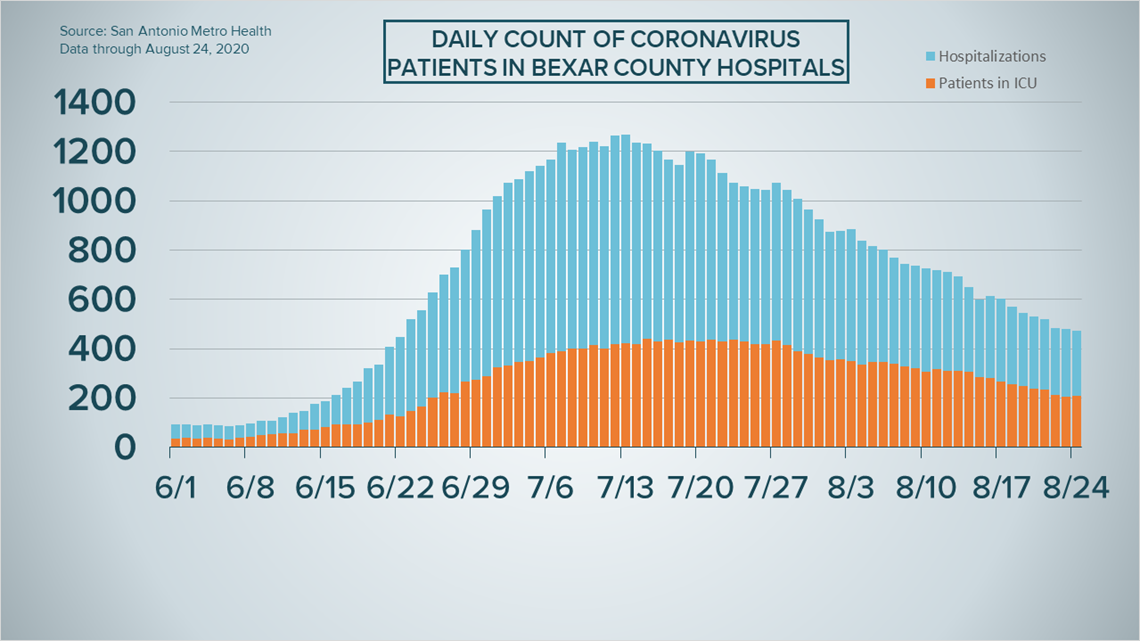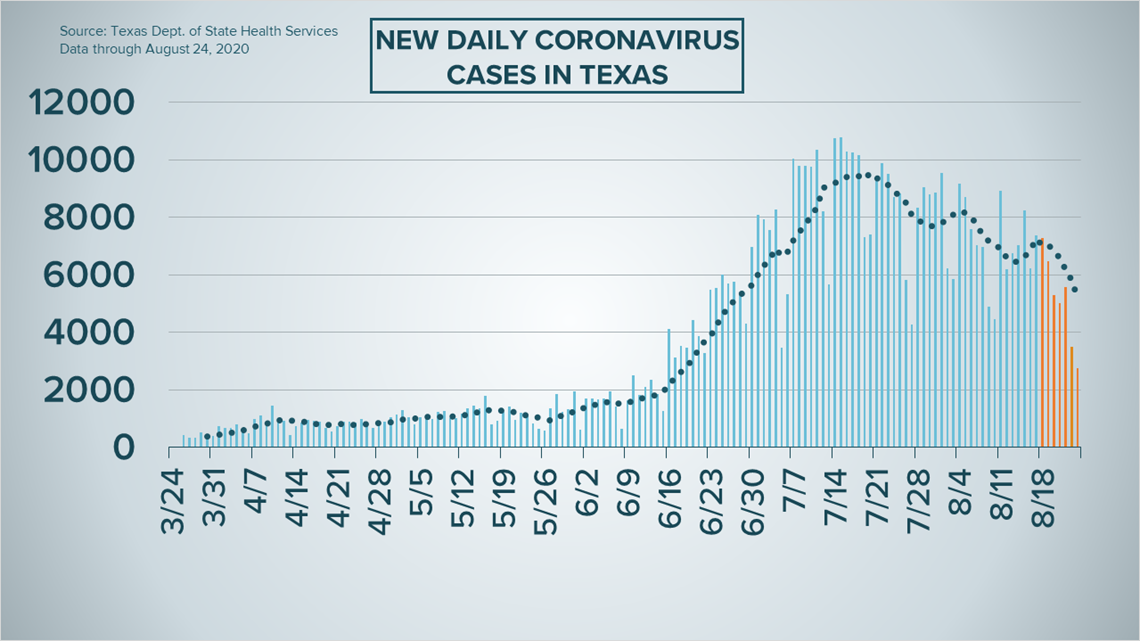SAN ANTONIO — We're tracking the latest numbers from the coronavirus pandemic in San Antonio and across Texas. Here are the latest numbers reported by Bexar and surrounding counties:
- Bexar County: 109 new cases were reported Monday, bringing the total number for the county to 45,364. The county death toll, meanwhile, rose to 725 after four additional fatalities were reported.
- Comal County: The county reported eight cases and no additional deaths Monday. There have been a total of 2,865 cases of COVID-19 in the county – including 2,275 confirmed cases – while 80 county residents have died. County officials say there are 519 active coronavirus cases, and 2,266residents are considered recovered.
- Hays County: Officials in Hays County on Monday reported 11 new cases and no additional deaths in the county. As of Tuesday evening, there were a total of 5,308 lab-confirmed cases in the county (2,393 of which are active) while the death toll stayed put at 45.
How Bexar County is trending
We've tracked how many coronavirus cases have been confirmed in Bexar County from the time officials began reporting cases in March 2020. The graphic below shows the number of cases since June and charts those daily case numbers along a 7-day moving average to provide a more accurate picture of the overall coronavirus case curve in our area and the direction we're trending amid the pandemic.
On Monday, San Antonio Mayor Ron Nirenberg reported an additional 109 cases of the novel coronavirus for Bexar County. In all, at least 45,364 Bexar County residents have tested positive for the virus. 7-day moving average drops to 148.
An additional four virus-related deaths were also reported for Bexar County Monday. That brings the local death toll to 725 since the pandemic began.


Hospitalizations continue to fall for Bexar County. On Monday, 473 residents were receiving treatment for COVID-19 symptoms; that's the lowest the number has been since June 22, when 446 patients we in the hospital.
The number of patients in intensive care went down slightly to 207, and the number of patients on ventilators dropped t at 139.


In Monday's address, Nirenberg broke down the weekly progress indicators, under which Bexar County is at a "moderate" risk level. The 14-day trend in cases in the county is moving steadily downward, and the average daily case number has dropped to 143. Nirenberg noted the gradual decline in hospitalizations as a positive indicator in reducing hospital stress.
The county's doubling rate is holding steady at 40 days, while the positivity rate of declined once again to 9.9%. For the first time in "quite some time," Nirenberg said, Metro Health reported a positivity rate below double digits. The goal is to get the positivity rate below 5% in order to reopen schools safely, Nirenberg said.
Coronavirus in Texas
The Texas Department of State Health Services on Monday reported an additional 2,754 cases of the novel coronavirus across the state, 93 of which came from a backlog of tests conducted in recent weeks. As of Monday, at least 580,384 Texans have been infected with COVID-19.


Meanwhile, the state reported an additional 25 coronavirus-related deaths, bringing the total to 11,395.
Hospitalizations due to COVID-19 continued their decline across the Lone Star State. On Monday, the number of Texans getting treatment for symptoms was down to 5,019. The last time the number was that low was June 26.
As the school year begins to get underway for local districts, we are also keeping track of the most important updates for each, including links to dashboards created to track coronavirus cases.
Latest Coronavirus Headlines
- Need to 14-day quarantine after travel? CDC says consider where you've been
- Scientists say Hong Kong man is first confirmed case of coronavirus reinfection
- President Trump announces plasma treatment authorized for COVID-19
- Feeling alone in the pandemic? Robotic pets can serve as a companion
- As shoppers stay away, small stores seek refuge online
- More than 200 positive COVID-19 tests from Walgreens backlog attributed to Bexar County
Coronavirus symptoms
The symptoms of coronavirus can be similar to the flu or a bad cold. Symptoms include fever or chills, cough, shortness of breath or difficulty breathing, fatigue, muscle or body aches, headache, new loss of taste or smell sore throat, congestion or runny nose, nausea or vomiting and diarrhea, according to the Centers for Disease Control.
Most healthy people will have mild symptoms. A study of more than 72,000 patients by the Centers for Disease Control in China showed 80 percent of the cases there were mild.
But infections can cause pneumonia, severe acute respiratory syndrome, kidney failure, and even death, according to the World Health Organization. Older people with underlying health conditions are most at risk.
On June 25, the CDC expanded the list of groups at a higher risk of severe illness due to coronavirus.
Experts determined there was consistent evidence these conditions increase a person's risk, regardless of age:
- Chronic kidney disease
- COPD (chronic obstructive pulmonary disease)
- Obesity (BMI of 30 or higher)
- Immunocompromised state (weakened immune system) from solid organ transplant
- Serious heart conditions, such as heart failure, coronary artery disease, or cardiomyopathies
- Sickle cell disease
- Type 2 diabetes
The CDC believes symptoms may appear anywhere from two to 14 days after being exposed.
Human coronaviruses are usually spread...
- Between people who are in close contact with one another (within about 6 feet).
- Through respiratory droplets produced when an infected person coughs, sneezes or talks. These droplets can land in the mouths or noses of people who are nearby or possibly be inhaled into the lungs.
- Some recent studies have suggested that COVID-19 may be spread by people who are not showing symptoms.
Help stop the spread of coronavirus
- Stay home when you are sick.
- Eat and sleep separately from your family members
- Use different utensils and dishes
- Cover your cough or sneeze with your arm, not your hand.
- If you use a tissue, throw it in the trash.

